Sony FX6 preorders are now open!
Preorders:
Sony FX6 FF E-mount camcorder at BHphoto, FocusCamera and Adorama.
Sony FE C 16-35mm T/3.1 G E-Mount Lens at BHphoto, FocusCamera and Adorama.
And here are some more FX& youtubers tests:
Preorders:
Sony FX6 FF E-mount camcorder at BHphoto, FocusCamera and Adorama.
Sony FE C 16-35mm T/3.1 G E-Mount Lens at BHphoto, FocusCamera and Adorama.
And here are some more FX& youtubers tests:
Sony A7c at BHphoto, Adorama, Amazon, FocusCamera. Calumet DE. Foto-erhardt DE. Fotokoch DE. Wex UK. Park UK.
Dustin Abbott published his definitive and very long Sony A7c review:
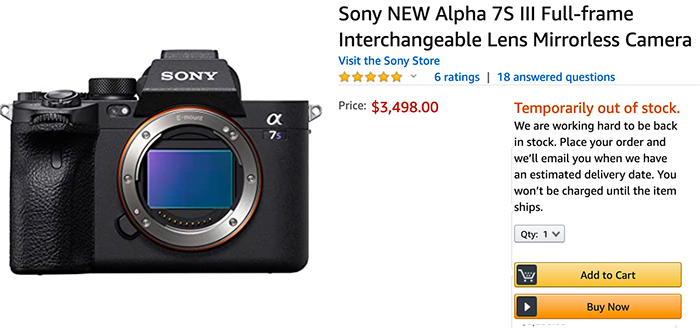
Sony A7sIII preorder at Adorama. BHphoto. Amazon. FocusCamera. Fotokoch. Calumet DE. WexUK. Park UK.
David Pardue from Engadget tested the A7SIII and concluded:
I can’t find many faults with this camera. Sony has addressed nearly every complaint I’ve ever had about previous A7-series cameras, but it didn’t just stop there. It also improved autofocus and other features that I already liked, keeping the A7S III far ahead of rivals.
Its limitations are down to the high $3,500 price tag and low-resolution sensor, which rules out the A7S III for landscape and other types of high-detail photography. If you need that, get Sony’s similarly priced A7R IV with a category-leading 61 megapixels.
If budget is an issue and you need an all around hybrid camera, check out the Canon R6, Panasonic S5 or Sony’s own A7 III, all between $2,000 and $2,500. However, if you’re into video or low-light photography and have the budget, I’d highly recommend the A7S III. Feature for feature, it’s simply the best camera I’ve ever tested.
Preorders:
In the USA at BHphoto, Adorama, Amazon, FocusCamera.
In Europe at Calumet DE. Foto-erhardt DE. Fotokoch DE. Wex UK. Park UK.
Sony HVL-F28RM External Flash at BHphoto.
—
Explora (Click here) published this Sony A7c spec comparison table.
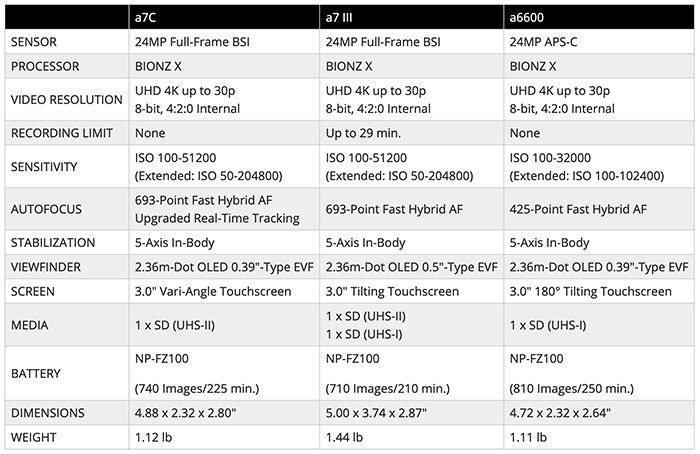
Opticallimits tested the Sony FE 20mm f/1.8 G and they really liked the lens performance:
In the grand scheme of things, the Sony G lenses seem to be a bit underappreciated whereas the GM lenses collect all the glory. However, we think that the G series could actually be THE reason for serious amateurs to prefer the Sony system over Canon/Nikon/L-mount. These lenses strike the perfect balance between costs and performance. The Sony FE 12-24mm f/4G, 90mm f/2.8G, FE 24-105mm f/4G, and FE 200-600mm f/5.6-6.3G are all excellent choices … and so is the Sony FE 20mm f/1.8G.
The Sony lens offers breathtaking sharpness in the broader center zone at all mainstream aperture settings. The corner performance isn’t quite as high but it’s very usable at f/1.8 already and very good at medium aperture settings – all with minimal field curvature and low astigmatism. As such the lens is also feasible for astrophotography. The native image distortion is low and nicely corrected in auto-mode. The same goes for lateral CAs. The biggest weakness of the lens is vignetting. It’s rather extreme at f/1.8 in raw files and not overly impressive even at f/5.6. Image auto-correction comes to the rescue here as well so usually, you will just spot some light falloff at f/1.8. An almost baffling aspect is the quality of the bokeh. Wide-angle lenses are usually rather mediocre in this respect – at best – whereas the FE 20mm f/1.8G is actually impressive with smooth highlight discs that can maintain a circular shape even in the image corners. And the general blur characteristic is good, too.
The build quality is excellent thanks to high-grade materials and a tight assembly. The lens doesn’t extend during focusing and is sealed against dust and moisture. Sony also added some mechanical goodies such as a dedicated aperture ring including a clickless mode and a focus stop button. You may argue that it would have been nice if they also added optical image stabilization but we think it’s good that they avoided this temptation. Especially ultra-wide lenses require precise centering and an image stabilization group would have made things more complex here – besides the extra costs. Another positive aspect is the compact size and low weight.
The Sony lens isn’t cheap to boot but then it’s also faster than your average 20mm lens. As a rule of thumb, an extra stop doubles the price tag. Keeping this in mind, the price of around 900USD/EUR is still reasonable. And we conclude our verdict with … highly recommended!
Sony 20mm f/1.8 FE G:
In USA at BHphoto, Amazon, Adorama. FocusCamera.
In EU at Amazon DE, Calumet DE. Amazon UK. Parkcameras UK. Amazon FR. Amazon IT. Amazon ES.
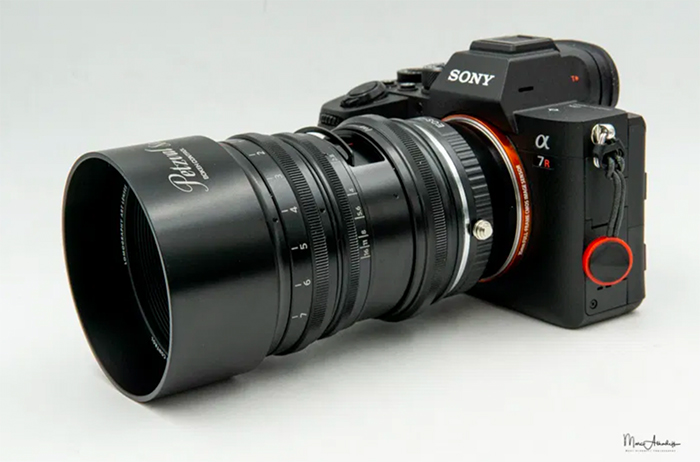
Marc Alhadeff from SonyAlphaBlog tested this rare Petzval 80.5mm f/1.9 Mark II lens:
The Lomography Petzval 80.5mm F1.9 Mark II Bokeh Control (499 euros) is an very nice Art lens and an excellent complement to the Petzval 55mm F1.7 MkII
In general “Art lenses” have a very poor sharpness, a vintage color rendition and some re-edition of vintage lenses are sold for crazy price (Around 1000 euros for Meyer Optik Lenses)
Here Lomography has found a very good alchemy with
A superb soft and creamy background blur
A Swirly bokeh effect you can adjust
Very nice Bokeh Balls
A very good and natural color rendition
A good to excellent sharpness in the centreOf course the lens is not perfect
It is not available in E mount directly (you need an adapter) whereas the Petzval 55mm F1.7 MkII is available in E mount. Compared to it it is much bigger and heavier
It will very difficult to focus outside of the centre and only 25-35% of the image will be sharp
It is not a generalist lens you can use everyday
The Waterhouse aperture / and Bokeh control are options you will not play often withGlobally for portrait, object details (flowers..) the lens is providing superb and unique results plenty of poetry
Also for video the lens is capable of producing subtle dreamy atmosphere while retaining plenty of details on your main subject
Highly recommended
With the S5 Panasonic released a very intresting enry level camera. The big problem is their autofocus performance when shooting videos. But put that aside and the camera is a worthy competitor of the Sony A7III. Here is the full report from Explora (article here).
For photography:
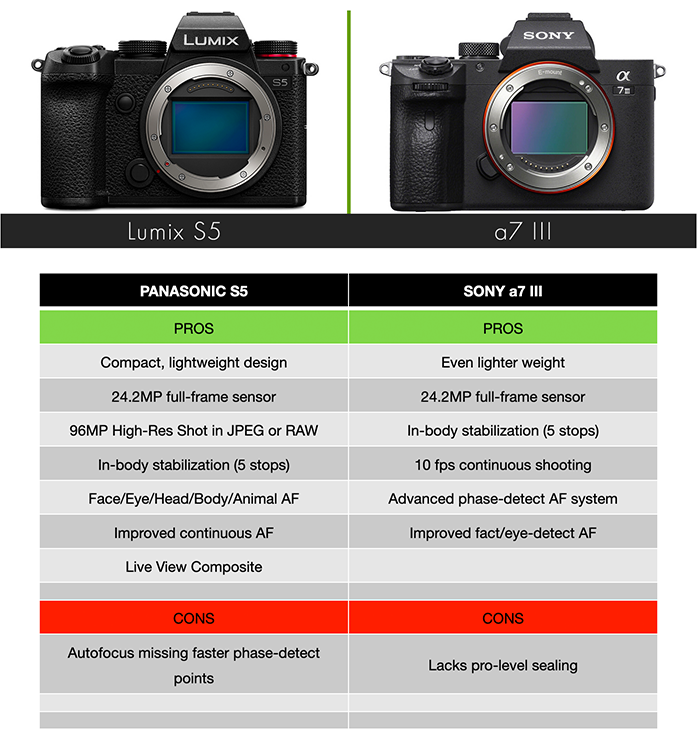
Pitting the S5 and a7 III against each other results in a very close battle. They seem to trade out features, making a decision based more on the specific things you want and less about which is flat-out better than the other. Panasonic offers advanced features like a High-Res Shot mode for 96MP JPEGs and raw images, Live View Composite, and plenty more. However, I believe the a7 III wins on some regular specs such as autofocus performance and continuous shooting. To be honest, pick whichever one you like best.
For video:
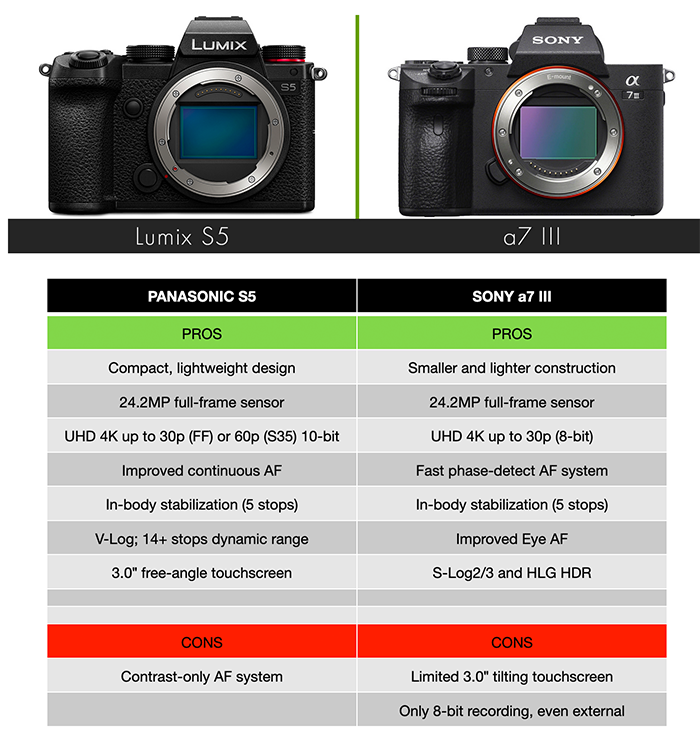
Videographers and filmmakers of all types will appreciate the advantages of the S5 over the a7 III—which is starting to show its age. The S5 offers 10-bit recording, which is incredibly important for high-quality video. It has a crop mode that enables 60p for 4K video. And, the screen is a free-angle design that is ideal for vlogging. The a7 III is still a great pick if you need photo performance as well, but the huge advantages of the S5 for video mean that if you are video first it is well worth it.